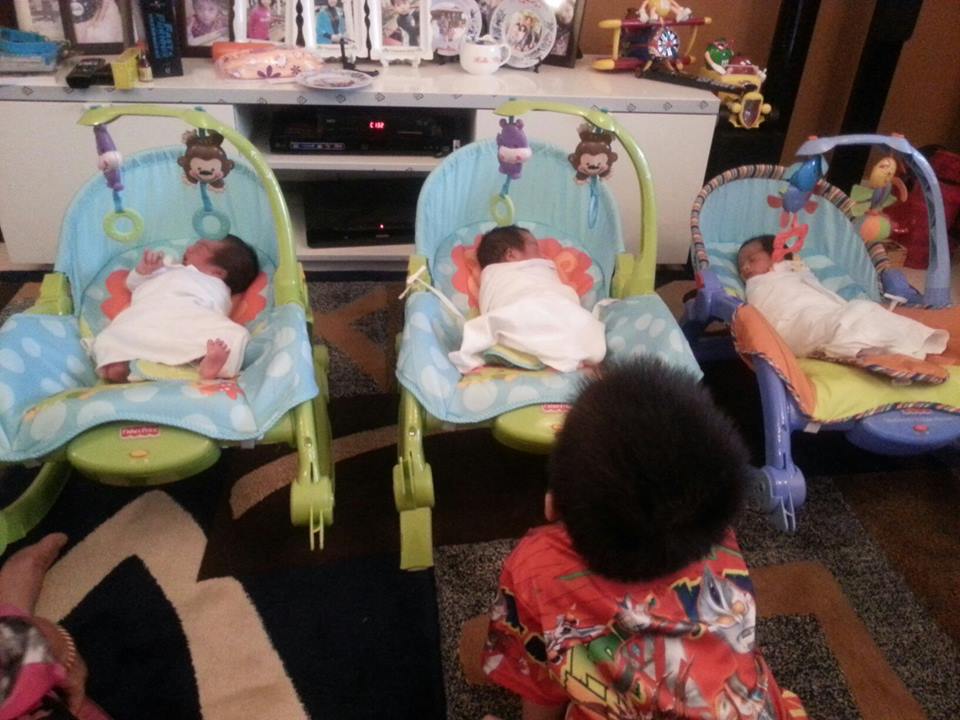7 Malaysian housewives reveal how much they spend on their hair

- 666Shares
- Facebook649
- LinkedIn1
- Email1
- WhatsApp5
Yes, we initially started writing this because of what Rosmah said recently. In case you didn’t know, here’s what happened.
At a GST event, Rosmah reportedly uttered these words which made social media go all apesh*t:
“Now when I want to dye my hair at home, the hairdresser charges me RM1,200. […] It is really hard to make tailored clothes these days. Their prices come up to RM500, and I am speaking as a representative of a housewife that buys made-to-order clothes.” – Rosmah Mansor
RM1,200 for hair dyeing services?! Yaomoukauchor?! RM1,200 can feed a family already leh!! And as a housewife, why is fashion and beauty the biggest concern, not health or education?? (…… said pretty much everyone.) In fact, her hair price complaint has even forced a Minister to look into service price hikes for GST.

OK, just to be fair to her… We’re sure that she said a whole lot more during the GST event and these quotes may have been chosen over other less-sensational words by Rosmah.And of course, as a figure representing our country, she needs to look presentable all the time (or does she?).
But WAIT. Do housewives actually spend that much on their hair? Do they really care about top-notch grooming? What is their biggest concern? CILISOS ber-kepoh with 7 Malaysian housewives to learn what it’s like to be in their shoes, asking them some pretty uncomfortable questions about money and budget and whatnot.
*Heads up: OK, look. This writer was supposed to talk about budgeting, but being the sentimental girl she is, she kinda went off topic a bit. Sorry Mr Editor*
But first, what makes a housewife?
The first thing someone remarked after hearing Rosmah’s statement was… “Is she even a housewife?”
Seeing that she’s tagged the First Lady of Malaysia and does all sorts of official work, that question is pretty legit la. The term ‘housewife’ is generally defined as ‘a married woman whose main occupation is caring for her family, managing household affairs, and doing housework‘. She doesn’t technically have an official job outside her home, too. Oh, and stereotypically messy.


The FLOM doesn’t have a salary, and to put things in perspective, neither does Michelle Obama despite being a damn hardworking FLOTUS.
So technically, Rosmah does check all points, making her a housewife.
Granted, a housewife in the household of the nation’s Prime Minister is a lot different compared to the household of normal rakyatfolk. The differences are big and wide, and for obvious reasons too. I mean, she’s one of the faces of the country, ugaiz. Of course la got different JD and support system.
Check out what she does on her daily routine in this surprisingly fascinating video with surprisingly 80s music:
Yeah… Badminton, visits, piano sing-songs, more visits… But like we said, different requirements la.
But how different, actually?
CILISOS KEPOH KORNER
(Arranged from lowest to highest monthly expenditure)
1. Jenny S., 63, Subang

Monthly expenditure: About RM1,100 – groceries (RM500), utilities (RM250), miscellaneous (RM300)
Household income level: Low-mid income
Household size: 3 people (Wife + 2 Adult sons)
Source of income: SOCSO + children
Pre-housewife life: Factory worker
Grooming & pampering: Dyes own hair at home, pampers herself through shopping (once a month)
Ready for GST? Save and eat out only if necessary.
“I guess that the effect would be great on lower income earners. I’ll definitely have to spend less on clothes and stop buying unnecessary things.”
——–
After Jenny’s husband passed away in 1991, she had to take care of her three children on her own. Other than receiving money from SOCSO, she also had to work as a part-time babysitter at home to ensure she could take care of the family and raise her children.

As they each turned 21 over the years, the SOCSO contributions lessened (doesn’t cover children over 21 as should be able to work). Today, she no longer needs to babysit to earn a living for her family as they’ve all grown up. Living a much more comfortable life today, she receives a monthly sum of money from SOCSO as well as contributions from her children.
Tracing back to her early days, she describes being a housewife as someone with a duty to take care of the family. As a widow, she had to ensure providing for the family every month, regardless of how difficult life could get.
“After getting married, I left my job and focused on my family. My life was and is totally devoted to them. My concerns are mainly for my children. Their health, their education… I simply must make sure that there’s food on the table, everyday.”
She recalls raising three kids as a widow as something extremely difficult, especially when they were still young. “Imagine. Three little kids, still in school. Money was so important to us,” she says. “Home-babysitting was my main income. I even did some home cleaning jobs for a few years to help pay the tuition fees. But truly, it was all worth it.”
*Ironically, when we asked if she’d go back to the workforce if she could, she said that she’d rather take care of her own kids instead of sending them to a babysitter!
2. Adeline L., 56, Klang

Monthly expenditure: About RM1,200 – mainly food, drinks, taking care of her parents and petrol (breakdown N/A). House and car loans paid off
Household income level: Mid-high income
Household size: 2 people (Husband + Wife)
Source of income: Husband
Pre-housewife life: Data entry OL
Grooming & pampering: Dyes hair once every two months in a salon (RM50), hair cut once every three months (RM25). Doesn’t do nails. Pampers herself by spending time with family.
“I’m not a fan of massages and all that… The way I pamper myself is by spending time with my family, especially my daughter. Once in a while, if she’s free, we’ll spend the day together by going shopping in the mall. Unfortunately, she’s always busy with work.”
Ready for GST? Eats out a lot because difficult to cook the right portion for two people, but foresees less eating out and more cooking at home.
“Not exactly sure how badly we’ll be affected. We’ll have to wait and see just how big the changes can be, and adjust accordingly.”
——–
A housewife of more than 27 years, Adeline was once working in an international company before giving up her job to care for her first child. “When my son was very young, we left him with a babysitter. There was an unfortunate incident which happened while my son was under her care, which made me quit my job to take care of him on my own,” she says.
“Our babysitter made a terrible decision while taking care of my very feverish baby boy. It made me realise that my child was in dangerous hands, so I made up my mind to care for my own son from thereon.”
Back then, Adeline also tirelessly ran a side job to help her husband raise the family. Today, they’ve gone past the trying stage of caring for her children as they are now adults in the working world, living on their own.
“I finally have time to completely enjoy my life right now,” she adds. “Now that my children are all independent, I can attend to my ageing mother. I’ll take her jalan-jalan, bring her to the doctor, spend some quality time with her… This is the time to care for her and it makes me happy to be there for her.”
On the best part of being a housewife, she said that there is no turning back time and that kids are only kids once. “There is so much joy in seeing your children grow up. I treasure each moment that I’ve had with them, knowing that I was with them every step of the way.”
3. Amalashri, 53, Ipoh
(image for illustration purposes only from Flickr)
Monthly expenditure: About RM1,300 – Utilities (RM500), food and drinks (RM500), medication (RM300)
Household income level: Low-mid income
Household roll call: 2 people (Husband + Wife)
Source of income: Husband
Pre-housewife life: N/A
Grooming & pampering: Not interested in fussing over beauty, adding that since her hair grows slowly, she only cuts it once or twice a year
Ready for GST? Still in progress
——–
Amalashri, a mother of two, is a simple lady with very few words.
At 53, most of her worries are put to rest both her children have grown up and no longer living with them. One has left to work, the other to study.
Her lifestyle is also pretty simple: both Amalashri and her husband don’t have phones with cameras!
And the things that make her happy, are also very simple: she’s happy when her family’s happy, she’s happy being there for them through good and bad times. And her challenges as a housewife? “When things don’t take place the way I planned for my family,” she quipped.
Back in the day, she decided to be a housewife instead of working a full-time job for the sake of her family. “My family members needed more attention,” she tells us. “In the past, there weren’t as many day care centres as there are today. It was my priority to attend to my children.”
4. Farah A., 29, Sungai Buloh
(image for illustration purposes only from Flickr)
Monthly expenditure: About RM2,800 – house maintenance fees (RM600), groceries (RM300), utility bills (RM200), weekly cleaners (RM180). Free internet and phone bills cos hubby works for telco. House and one car paid off.
Household income level: Mid-to-high income
Household size: 3 people (Hubby + Wife + 1 Toddler)
Source of income: Husband + a bit of freelance writing
Pre-housewife life: Full-time writer for a glamorous magazine, then helping out in a local NGO
Grooming & pampering: Hair treatment every six months or so (RM200-RM300). If badly stressed, goes for massage at favourite spa (about RM250), indulge in a little retail therapy or go wild in bookstores
Ready for GST? Haven’t thought about it as much as she should’ve.
“Due to current life circumstances, we are expecting big changes in the family and are being more careful with expenses anyway though.”
——–
“When my husband and I decided to have kids, I wanted to raise our child and not depend on others to do it. I didn’t want to rely on babysitters, maids or daycares, and I didn’t want to burden either set of parents with taking care of a grandkid on a daily basis when they should be done with all that,” she tells us.
Farah considers being a work-at-home mom a big juggling act.
“Each day I’m responsible for keeping a little human being alive and thriving, which means feeding, clothing, cleaning, entertaining, teaching, and everything in between. Somewhere between all that I have to figure out how to keep the house fairly livable, what food goes on the table at each meal, when the heck I’m supposed to shower.
Oh, and also how to write a 2,000 word article for that one magazine, create social media content for that organisation, and attend that meeting.”
Apart from that, she’s constantly struggling to find time to finish her work, feeling guilty whenever she plops her son in front of the TV for 10 minutes to send an email in peace. “I hate when I can’t be the ‘perfect’ housewife and can’t get that meal on the table or mop the floor because I’ve been too busy with other things.”
But what’s the best part about being a housewife?
“I get to be there for my son and see him grow up every day. I get to choose the topics I write about. And I get to avoid office politics.”
5. Sereen P., 22, Subang Jaya

Monthly expenditure: About RM3,800 – rent (RM1,500), utilities (RM800), groceries (RM800), car loan (RM700)
Household income level: Mid income
Household size: 4 people (Husband + Wife + 2 Toddlers)
Source of income: Husband + side business
Pre-housewife life: Student
Grooming & pampering: Minimal, only does nails during Christmas. Pampers herself with retail therapy (with good bargains)
Ready for GST?
“Yes, we’ve prepared for this change. How? Well, just bring extra cash if you’re buying anything! Can’t do much about the GST now, can you?”
——–
Our youngest interviewee, Sereen is often seen as a “child taking care of another child” as she bore her first child during her adolescent years. At 22 years old today, she now has two children of her own.
Her husband, who has a personal business dealing with spare parts for vehicles as well as his own father’s business in Nigeria, is the main income earner in this young household. As a young lady with an interest in fashion, she sells plus-sized clothes on Facebook to help make some extra cash. She also home-bakes cookies for the festive season.
That aside, we were curious about the challenges she faces as a housewife.
“It’s not easy being a young mother as people around me think that I’m not capable of caring for a child at a young age. However, I’m happy that my husband and I did the very best we could to make sure our kids are well taken care of.”
At home, it gets even more challenging if her kids decide to throw tantrums, demanding attention when she needs to attend to her online customers. Sometimes, she’ll need to leave them at her mother’s to concentrate on her work.
Although being a housewife is having to wear different hats 24/7, with no salary, annual leaves or MCs, she says that the best part of her ‘job’ is being around her kids all the time without relying on a day care centre.
“I can be closer to them, getting to know them as they grow.”
But would she want to do this for the rest of their lives? “The only reason why I’m a housewife is because my kids are too young to take care of themselves,” she says. “Once they learn how to live independently, I would definitely want to step into a real working environment.”
6. Grace L., 30, Kuala Lumpur

Monthly expenditure: About RM4,500 – mortgage (about RM2,000), food (RM500), groceries (RM500), petrol (RM500) and baby stuff (RM250).
Household size: 3 people (Husband + Wife + 1 Toddler)
Household income level: Mid-income
Source of income: Husband
Pre-housewife life: Grace used to work in the corporate world before she became a full-time housewife.
Grooming & pampering: Gets haircuts at express salons (RM18), but gets cut+wash+treatment (no more than RM400) for special occasions (such as CNY). Doesn’t believe in manicure/pedicure in a world of house chores and PlayDoh. Goes for facial once every two months (RM150).
“After getting married, must maintain meh?”
Ready for GST? Plans to save as much money as she can right now. Currently eats out most of the time, so will be cooking at home in the future.
——–
As her husband is the sole breadwinner of the family, Grace tries to be reasonable in her spending. “I don’t exactly have a budget or keep track of my spending, but I live by the ‘don’t need, don’t buy’ principle,” she tells us.
Like any young mother and housewife, her daily routine revolves around her little one. From a.m. to p.m., her daily routine consists of waking up early, preparing milk and food, cleaning after her son, playing with him (or “following him wherever he goes”), making him take his nap and cleaning the house until daddy gets home.
“I’m an admin staff, my own domestic helper, an educator, the head of housekeeping, an art teacher, a ‘Home Minister’… I have bionic ears, and if I wanted to, I could write a thesis on poop.“

While it may all sound tiring to us non-housewives, the payoff is incredible. Other than being by her son’s side every step of the way, Grace says that being a housewife means she’s able to skip the awful rush hour traffic. No more fighting with people for car parks as she can go to the mall anytime. She can be in her PJs the whole day, too.
“My son is close to me, his mommy. Not close to a guardian or a nanny.”
7. LQ, 54, Bangsar
(image for illustration purposes only from Flickr)
Monthly expenditure: About RM9,200 – food (RM5,000), general household stuff (RM3,000), domestic helper (RM1,200)
Household size: 3 people (Husband + Wife + Son (in college))
Household income level: High income
Source of income: Husband
Pre-housewife life: Accountant
Grooming & pampering: Monthly hair cut and hair dye job (RM1,000) (OMG!!!!), nails (RM100) and massages (RM450).
Ready for GST?
“No, [we haven’t prepared for the change, we’re] not really affected.”
——–
Also another lady of few words, LQ became a housewife after retiring from employment. Living a comfortable lifestyle, she tells us that her husband is the current and only breadwinner of her household. They also have a child who’s in his 20s and studying in a private university in KL.
But despite all that, she’s aware of the duties of a housewife. “A housewife’s duty is to make sure that the house is clean and comfortable, that there’s food on the table,” she says. “However, I think that these concerns about life applies to every individual as a person, and not necessarily a housewife.”
So what are the challenges faced by a housewife in this income level? I mean, are there any??
“Although it’s nice that I’m in control of my own time, it can be pretty boring if you don’t use your free time productively.”
Wah. So yes, people do spend that much on hair k?
Okay, so we did find a housewife who spends RM1,000 on hair. But hey, if it’s her money, then who are we to judge? Well, perhaps it’s not so much the money you spend, but how you (or your family) attained it that’s the issue? The things Rosmah does aren’t too different from what someone like Michelle Obama does.
Perhaps if the first family of Malaysia was more transparent about their income, we’d be a bit more accepting of occasionally indulging in the luxuries we all would love to enjoy.
“The financing of the first lady’s wardrobe is something the Obama White House is loath to discuss. It’s a subject that has bedeviled presidents and their wives for centuries. First ladies are expected to dress well, but the job doesn’t come with a clothing allowance or a salary.
How does Mrs. Obama, a fashion icon with far more expensive tastes than Mrs. Bush, swing it? For starters, the Obamas reported adjusted income of $481,000 last year, and assets worth $1.8 million to $7 million. And like most people, Mrs. Obama (mostly her personal aide, really) looks for discounts.” – The Daily Mail, 30 May 2014
The Obamas, for instance, earn quite a bit of their money from book sales, for which they donate 14% of their taxable income to charity. Would we begrudge the first family if they earned off book sales and spent a bit on luxury? Of course, it’s a different matter when it might be taxpayer money.
On another note, it’s undeniable that most of these housewives share three key similarities:
1. Their family is their world.
2. They don’t really give a hoot about their beauty.
3. Despite the sacrifices they had to make for being a housewife, they wouldn’t trade what they have for anything in the world.
And for that, CILISOS salutes you, housewives of Malaysia.
- 666Shares
- Facebook649
- LinkedIn1
- Email1
- WhatsApp5






